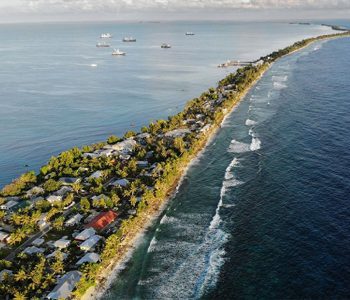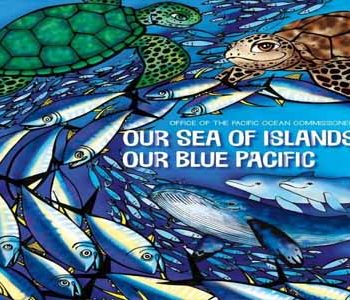 News Feed
News Feed
Tuvalu Could Disappear Into The Sea This Century, And…
Small islands in the Pacific Ocean will disappear due to climate change. But there is no attention at the top in Egypt for the population that will have to leave. ‘We are sinking’. (Original article by NRC.)
Kelesoma Saloa (52), a bulky man with soft eyes, mourns his homeland. Tuvalu, a group of islands in the Pacific Ocean, is slowly being swallowed by the sea. “I get scared when I think of that little island in the middle of that huge ocean,” he says.
While world leaders in Sharm el-Sheikh are once again trying to hold each other to the goals of the 2015 Paris climate agreement, climate refugees like Saloa have already lost hope. “I carry the worries of Tuvalu with me every day. ‘Cause I know it doesn’t get any better. It’s only getting worse.”
Tuvalu is only 26 square kilometers in size. It consists of three coral islands and six atolls, donut-shaped islands where the top of the island has disappeared due to erosion and water remains in the middle. About 11,000 people live on these narrow strips of land, surrounded by an endless sea. There is not a mountain or even a hill to be seen.
That makes Tuvalu, and other low-lying Pacific island states such as Kiribati, Vanuatu and the Marshall Islands, extremely vulnerable to rising sea levels. “One big wave could sweep across the country,” Saloa says. That is no exaggeration, two of the nine islands of Tuvalu have already largely disappeared. If the temperature on Earth rises by more than two degrees, as it probably will at the current rate, Tuvalu will completely disappear under water before this century.
The Polynesian country is therefore a symbol of the consequences of climate change. During the climate summit in Glasgow last year, Tuvalu stood out because of the speech by Foreign Minister Simon Kofe. He sent a video in which he was standing in water up to his knees, in a place where there was previously land. “We are sinking,” he said.
But even now the islands are slowly becoming uninhabitable. The advancing salt water penetrates deep into the ground, so that crops no longer grow properly. Due to the salinization of the groundwater, Tuvalu depends on rain for drinking water, precious water and food have to be imported. After long periods of drought, a state of emergency was declared this week; the inhabitants are on a water ration.
Tropical storms are also becoming more frequent, resulting in erosion and subsidence, which are also causing the islands to disappear.
Kelesoma Saloa saw the number of floods increase and felt compelled to leave his country. Because his wife Atalani had grown up in New Zealand, he was able to get a visa. In 2012, the family moved to Auckland, often referred to as the Polynesian capital of the world. More than 300,000 people from the Pacific live there.
Saloa now lives in the west of the city, in a low bungalow along a road where cars race past. It’s a gray day in Auckland. Inside are woven mats of palm leaves, colorful flower wreaths and beaded necklaces hang on the walls. In the center of the fireplace is a photo of his father sitting on the seawall in front of their home in Tuvalu. The wall is high enough for now, but not for much longer.
Culture shock
Kelesoma had hoped his whole family would follow, but his brothers decided to stay. He speaks softly when he talks about his homeland. “I didn’t want to leave my parents. But my father passed away unexpectedly when we first arrived in New Zealand. I couldn’t say goodbye. My mother did come after that, but she couldn’t settle. She couldn’t stand the cold here,” says Saloa. The culture shock still hits him hard. “I’ve lived here for seven years now and I still don’t know the names of my neighbors.” In Tuvalu he knew everyone. “We all live there together, like one big family.”
stay or leave; it was an impossible choice and it will remain so after seven years. “I feel like a coward,” Saloa says with wet eyes. “I have abandoned my country, my community.”
He hasn’t been home for years. It takes a small fortune to get to Tuvalu. Travel must be via Fiji with a propeller plane that departs twice a week to the capital Funafuti. Still, Saloa hopes that one day he can show his country to his children. “I hope we can go to Tuvalu one last time before the land disappears under water and my children have to sail in boats to point to our house, where fish now live.”
It is not clear how many people have left like Saloa because of climate change. Officially, climate refugees do not exist. People fleeing from rising sea levels, drought or increasing natural disasters cannot invoke the UN Refugee Convention. This only applies to those fleeing violence and persecution. Meanwhile, according to the United Nations, every year some 20 million people are displaced by climate disasters, such as extreme weather.
Usually people flee within their own country, to cities or to higher areas that offer more protection. But small island states like Tuvalu, Kiribati, the Marshall Islands and Vanuatu have no higher land for people to turn to when the sea swallows the lowlands. Those who can afford it and can arrange a visa, therefore, increasingly go abroad.
Domain Name
Other factors also play a role, such as work and education. Tuvalu has been one of the poorest countries in the world since it gained independence from the British Empire in 1978. That suddenly changed in 2000 when the country sold the domain name .tv for 50 million dollars. But it is not enough to guarantee a good future for everyone.
So people like Saloa count as economic migrants, because as climate refugees they have no legal leg to stand on. This became apparent when a man from Kiribati tried to apply for asylum in New Zealand in 2013 as a climate refugee. He stated that the rising sea level threatens his home and life in Kiribati. After a long battle, the Supreme Court rejected his asylum request in 2015, and he was expelled from the country.
That is why migration should be high on the agenda at the climate summit, according to former Kiribati president Anote Tong. “Small island nations in the Pacific have until 2060 before the countries are completely uninhabitable,” he says. He considers it inevitable that people will eventually have to move. “We cannot disappear into the sea like our country,” says the former president.
Tong was president of Kiribati, a country of more than 120,000 inhabitants, from 2003 to 2016. In 2014, he decided to buy a piece of land in Fiji for sixty to seventy thousand people, although his successor Taneti Maamau now uses the land for agriculture. The ex-president was with Thomas (‘Tommy’) Remengesau, former president of the Palau archipelago, in the Australian capital Canberra in September to lobby for the protection of their countries. “Because we are no longer government leaders, we can talk about our concerns passionately and directly,” Remengesau says. He has brought some shell necklaces with him from his country. He gives these to politicians he speaks to, to connect them to the islands. “The time for polite requests is over, it’s a matter of life and death.
Statelessness Convention
The question many Tuvaluans grapple with is what happens to residents of a country when it ceases to exist. The United Nations Statelessness Convention grants people the right to nationality, but the UN admits that climate change is putting this right under pressure. Yet climate migration is not a separate item on the agenda during the 27th climate summit in Egypt.
That is a missed opportunity, argue Elizabeth Ferris, professor of international migration at Georgetown University and researcher Reva Dhingra in the journal of the American think tank Brookings. “Climate migration will only increase. It is of the utmost importance that people are helped with this,” the two write.
It is a dilemma for many island nations. Governments don’t want to throw in the towel by admitting that many residents have to leave. In September, leaders of low-lying islands in the Pacific presented the ‘Rising Nations’ initiative at the United Nations. Kausea Natano, Prime Minister of Tuvalu, urged the international community to recognize the sovereignty and cultural heritage of these islands, even if they no longer exist in the future.
But this initiative is also based on adaptation, adaptation to climate change, and not on climate migration. So far, only Fiji and Vanuatu have made a national migration plan, though it doesn’t specify the exact numbers of residents to migrate and where to go. That is why the international community must step in, say the Brookings researchers. The climate financing of $100 billion per year from 2020, which was already pledged to developing countries in 2009, can contribute to this. “Where is that money? And how can it be used for climate mobility?”
It is well known that countries that are most impacted have often contributed the least to climate change. That is why lawyers are looking at whether rich countries that have caused the most emissions can be held liable. The Dutch climate lawyer Margaretha Wewerinke-Singh (37) is one of the pioneers of this initiative, which will probably be voted on by members of the United Nations before the end of the year. On behalf of the Vanuatu archipelago, she asks the International Court of Justice in The Hague about the obligations of rich countries to limit the consequences of climate change. If most UN countries agree to the request for advice from the court, it will be the first time that it will consider climate change and human rights.
:strip_icc()/s3/static.nrc.nl/bvhw/files/2022/11/web-1211zatbijklimaat10.jpg)
Large shrimp
Of the approximately 5,000 Tuvaluans in New Zealand, more than 4,000 live in Auckland. On a Saturday in October, a few hundred of them gather in a suburban gym. On long tables are bowls full of king prawns, a whole pig, and local dishes such as taro, a root vegetable. The party to commemorate Hurricane Bebe, which wreaked havoc on the islands fifty years ago, starts early in the morning and lasts into the night. It is a celebration of the resilience of Tuvaluans.
The highlight is the fatele, the traditional Tuvaluan dance. Men and women sit on the floor singing while they beat the rhythm on a large box. Women in grass skirts and with wreaths of flowers dance barefoot. They gently rock their hips and move their arms slowly, as if bobbing on the waves.
Lotonui Iosefa-Naisali (31) dances the fatale that is unique to her island of Nukulaelae, one of the atolls of Tuvalu, with about three hundred inhabitants. She moved to Auckland when she was seven, but still isn’t quite at home in New Zealand. “I’ve felt for a long time that I had to leave a part of myself behind to adapt,” she says.
She has only been wearing her Tuvaluan background with pride for a few years now. She has a white flower garland on her curly hair, which flows over her shoulders. She fears that her culture and language will fade into oblivion as more and more people leave the islands. “In Tuvalu we are connected to the land and the ‘moana’, the sea. When we lose that connection, we also lose part of our identity,” says Iosefa-Naisali.
Her father, Suamalie Iosefa-Naisali, is one of the community leaders in Auckland. He has an urgent appeal to the international community in Egypt. “Save Tuvalu, you will save the world,” says Naisali. “If we can save a tiny country like ours from extinction, there is also hope that the rest of the world can be saved from the worst effects of climate change.”
Kelesoma Saloa tries to speak as much Tuvaluan as possible with his children, although they often answer in English. “The bond is broken,” he says dejectedly. “They don’t know Tuvalu. They never walked on the beach by moonlight, celebrated, lived everyday life. They have no idea.”
Saloa knows he won’t be the last to mourn his home. “Tuvalu may be the first to go down, but the whole world is at risk. This is the only home we have. We must do what we can to save it, it is almost too late.”











